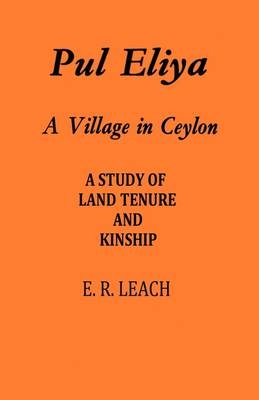
Pul Eliya
A Village in Ceylon
Seiten
2011
Cambridge University Press (Verlag)
978-0-521-20021-9 (ISBN)
Cambridge University Press (Verlag)
978-0-521-20021-9 (ISBN)
The North Central Province of Ceylon is an arid plain where habitation is possible only with the help of an elaborate irrigation system. This 1961 book analyses how land was owned used and transmitted to later generations in one of these irrigation-based communities, the village of Pul Eliya.
The North Central Province of Ceylon was the focus of a major civilisation which flourished between the third century BC and the twelfth century AD. The area is an arid plain where habitation is possible only with the help of an elaborate irrigation system; and the existing villages use the same irrigation works as the villages of antiquity. This 1961 book is a detailed analysis of how land was owned used and transmitted to later generations in one of these irrigation-based communities, the village of Pul Eliya. The main emphasis is placed on the way the ties of kinship and marriage are related to property rights and the practices of land use. The approach to this question provides a critical test of certain features of the theory and method of contemporary social anthropology. The factual evidence is very detailed, and the author allows the facts to speak for themselves wherever possible.
The North Central Province of Ceylon was the focus of a major civilisation which flourished between the third century BC and the twelfth century AD. The area is an arid plain where habitation is possible only with the help of an elaborate irrigation system; and the existing villages use the same irrigation works as the villages of antiquity. This 1961 book is a detailed analysis of how land was owned used and transmitted to later generations in one of these irrigation-based communities, the village of Pul Eliya. The main emphasis is placed on the way the ties of kinship and marriage are related to property rights and the practices of land use. The approach to this question provides a critical test of certain features of the theory and method of contemporary social anthropology. The factual evidence is very detailed, and the author allows the facts to speak for themselves wherever possible.
List of illustrations; Acknowledgements; Note to Reader; 1. Introduction; Pul Eliya: the general background; 3. The Pul Eliya land map; 4. The kinship system; 5. Traditional land tenure; 6. Non-traditional land tenure; 7. The organisation and reward of labour; 8. Conclusion; Appendices; references; General index.
| Erscheint lt. Verlag | 28.4.2011 |
|---|---|
| Zusatzinfo | Worked examples or Exercises |
| Verlagsort | Cambridge |
| Sprache | englisch |
| Maße | 140 x 216 mm |
| Gewicht | 470 g |
| Themenwelt | Sozialwissenschaften ► Ethnologie |
| Sozialwissenschaften ► Soziologie | |
| Wirtschaft ► Betriebswirtschaft / Management ► Rechnungswesen / Bilanzen | |
| Betriebswirtschaft / Management ► Spezielle Betriebswirtschaftslehre ► Immobilienwirtschaft | |
| ISBN-10 | 0-521-20021-0 / 0521200210 |
| ISBN-13 | 978-0-521-20021-9 / 9780521200219 |
| Zustand | Neuware |
| Haben Sie eine Frage zum Produkt? |
Mehr entdecken
aus dem Bereich
aus dem Bereich
Handbuch für Studium und Praxis
Buch | Hardcover (2023)
Vahlen (Verlag)
79,00 €
Erfolgsstrategien für den modernen Immobilienmarkt
Buch | Softcover (2024)
ForwardVerlag
18,00 €
warum Rene Benkos Immobilienimperium zusammenbrach und was dem …
Buch | Hardcover (2024)
FinanzBuch Verlag
22,00 €


